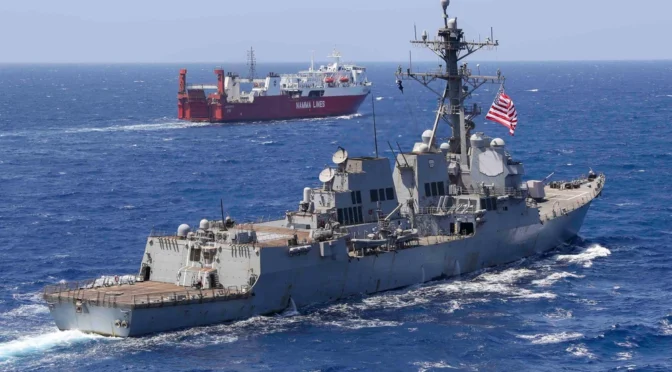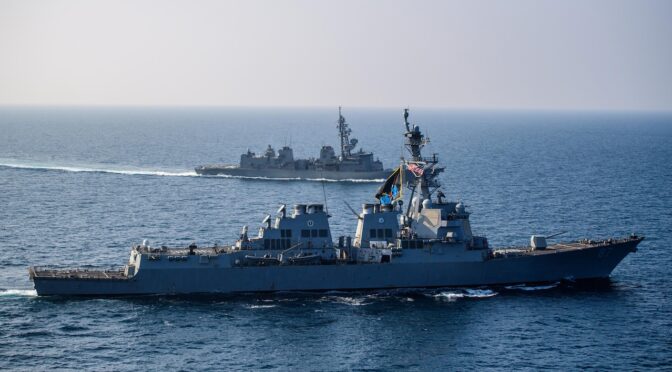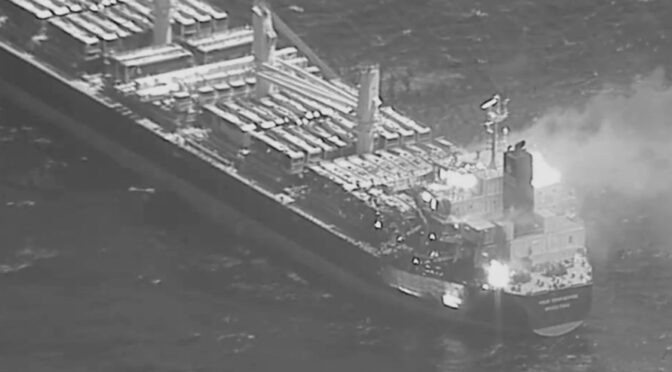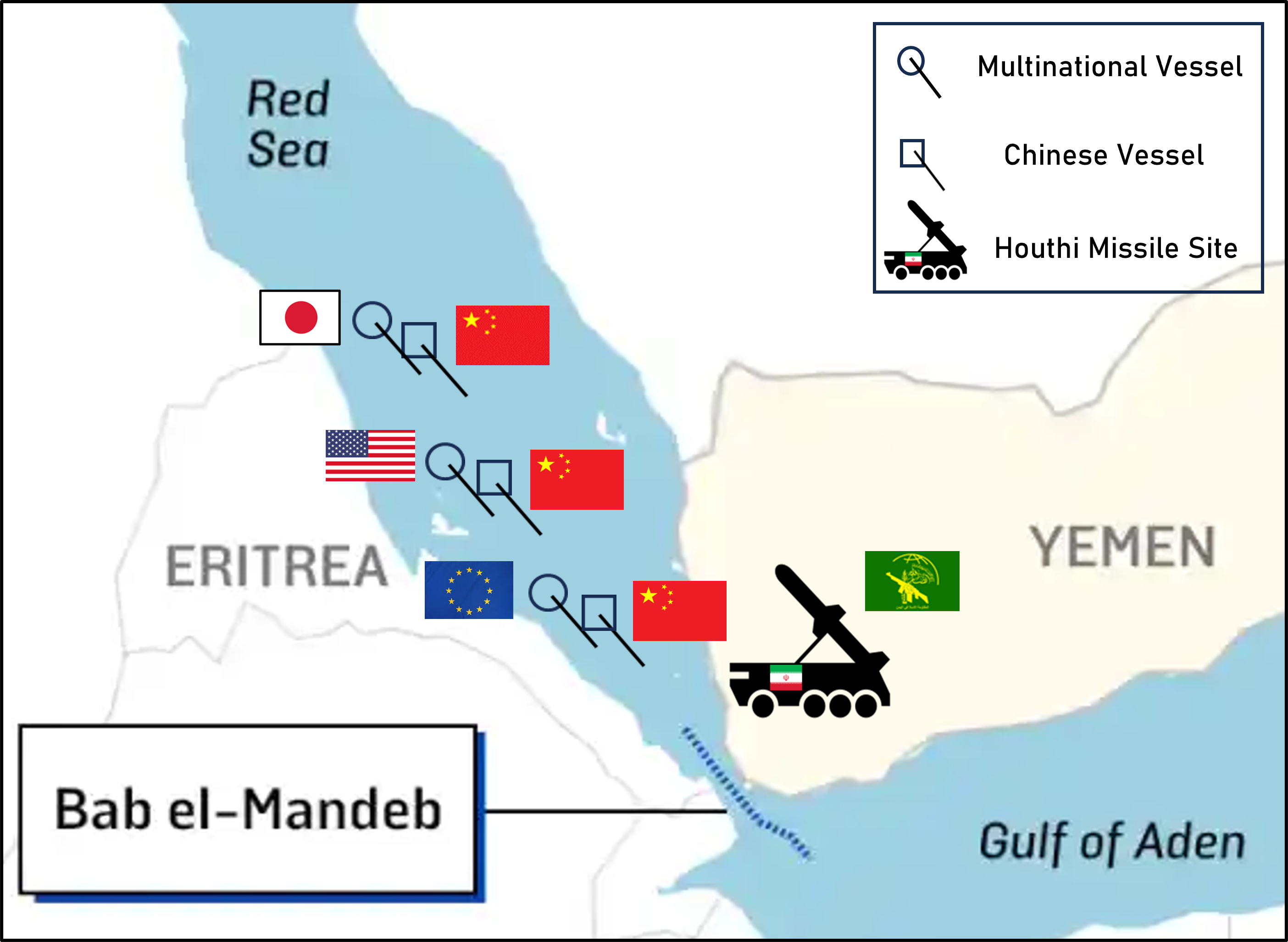By Michael D. Purzycki
American missile strikes on Houthi forces threatening shipping in the Red Sea show the Navy’s importance in protecting one of the busiest trade routes on the planet. Aggression by Iran and its proxy forces throughout the Middle East shows no signs of abating. In light of this reality, the Navy’s workhorses, Arleigh Burke-class destroyers, likely look forward to more action in the region as their construction continues thirty years on. Despite countering China in the Indo-Pacific becoming the primary focus of maritime strategy and deterring Russian aggression, the U.S. still benefits from maintaining a naval presence in the waters around the Arabian Peninsula.
Getting vessels to the Red Sea and other bodies of water east of the Suez Canal is resource- and time-consuming. For example, it takes approximately 20 days for an aircraft carrier homeported in San Diego to reach the Middle East. Moreover, any vessel from the Pacific Fleet deployed to the Middle East will not be available to protect American interests and allies in the western Pacific. Should China invade Taiwan and the U.S. find itself needing additional destroyers, America’s ability to patrol the Red Sea would be severely limited.
U.S. vessels can also sail from the East Coast, crossing the Atlantic and the Mediterranean before transiting through the Suez Canal; however, American access to the canal is not guaranteed. Egypt’s economy is far from stable. In March 2024, Egypt accepted a multibillion-dollar bailout from the International Monetary Fund to decrease its large national debt. Furthermore, despite being a longstanding U.S. ally receiving over $1B a year in aid from Washington, Egypt’s military is increasingly reliant on Russia for its weaponry. Meanwhile, a $28.5B surge of Chinese money in 2018 and 2019 made Egypt the number one Arab recipient of Chinese investment.
These factors make Egypt vulnerable to pressure from America’s rivals. For example, Egypt may face another wheat shortage, as it did in the early stages of Russia’s war in Ukraine. Russia could offer Egypt food aid in exchange for denying the U.S. access to the Suez Canal. Similarly, China could seek to pressure Egypt via “debt trap diplomacy,” placing the country deep in debt with the promise of relief if Cairo ceased being friendly to Washington. When sending vessels eastward through the canal, the U.S. Navy needs a backup plan.
The need for a U.S. naval presence in and around the Red Sea, combined with the uncertainty of America’s ability to regularly send vessels to that region, portends the basing of U.S. vessels in or around the Fifth Fleet area of responsibility. First, a willing host country must be found. While the Navy’s Task Force 59 demonstrated the ability of unmanned vessels to perform certain tasks in countering Iranian naval forces, the need to confront the Houthis, future Iranian proxies, or similar threats on land points to destroyers as the weapons of choice. Basing destroyers in the region rather than rotating them through would demonstrate the U.S. is committed to protecting global trade and confronting Iran’s threats to it, even as it sees the Indo-Pacific as the Navy’s primary theater in the coming years. It would also reduce transit times, increasing responsiveness while preserving hull service life.
The Navy need not be alone in basing forces in this part of the world. In a Brookings Institution paper, “How to Be a “Cheap Hawk” in the 2020s,” defense expert Michael O’Hanlon advocated basing U.S. Air Force tactical fighter squadrons in the Middle East, including Kuwait, Oman, and the United Arab Emirates. This would help the U.S. deter Iranian aggression without the burden of rotating Air Force F-15Es or F-35As to the Gulf from other regions, incurring significant logistical burdens with each rotation. The basing of naval vessels is complementary to this logic.
The deployment of U.S. destroyers to Naval Station Rota, Spain, for more than a decade provides an example of the value of a similar deployment east of Suez would bring. While their primary mission is missile defense, protecting NATO members against potential Russian attack, their proximity to North Africa and the Levant provides availability for contingency operations. For instance, they may perform missions similar to the anti-Houthi strikes, or to quell a resurgent Islamic State. Pleased with the capabilities provided by the arrangement, the Navy is increasing the number of destroyers based in Rota from four to six. The question of where American ships should be based is difficult to answer. Several possibilities present themselves, all of which have pros and cons. Perhaps the most glaring issue is that all the countries discussed below are within range of Iran’s ballistic missiles, some fitted with maritime seekers to target ships. While this is an issue worth considering, the benefits of nearby basing account for almost every contingency other than full-blown war in the region. Discussed below are four potential host countries.
United Arab Emirates (U.A.E.)
The U.A.E. has major ports potentially available for basing U.S. ships. For example, Jebel Ali is the Navy’s busiest foreign port. Political factors work in the Navy’s favor. The U.A.E. and Bahrain were among the first Arab countries to sign the Abraham Accords, ending their longstanding non-recognition of Israel. It is also part of I2U2, a multilateral partnership consisting of India, Israel, the U.A.E., and the U.S. While not primarily a security partnership, it can facilitate security cooperation between countries whose interests sometimes align.
Security may be an issue in the U.A.E., especially regarding China. The U.A.E. collaborated with China to provide domestic network services, acquire drones, and develop artificial intelligence systems. In 2021, China was forced to abandon constructing a major facility in the U.A.E. after the U.S. alleged that it had military purposes. Before the U.S. decided to base warships in U.A.E. ports, it would need to ensure the U.A.E. took strong measures to prevent China from compromising its utility.
Oman
Oman may offer the best geographical location. It is close enough to the Iranian coast and the Red Sea so that U.S. ships based there could quickly transit between them. Tying Oman to the U.S. through basing, and possibly with a major non-NATO ally status attached, could make up for the fact that Oman has refused to sign the Abraham Accords. Furthermore, the United Kingdom operates a major military presence in Oman, offering a chance to further Anglo-American cooperation on Middle East security threats.
On the other hand, Oman has worked for many years to maintain good relations with Iran and the U.S. It may refuse to be forced to choose between one or the other. The fact that the U.S. used Omani facilities does not mean that the interests of Omanis and Americans are aligned.
Kenya
If the U.S. is looking for a location more suitable for operations in the Red Sea than for countering Iran, Kenya would be a good choice. The country has the potential to be an important partner for the U.S. in and beyond Africa, and its international actions in recent years have frequently been conducive to American interests. In 2022, Kenya’s ambassador to the United Nations gave a stirring condemnation of Russian aggression against Ukraine. More recently, Kenya signed a deal with Haiti to allow Kenyan police officers to serve as peacekeepers in the troubled Caribbean country. A presence in eastern Africa can also help the U.S. counter China in the western Indian Ocean. Also, as with Oman, the United Kingdom maintains a military presence in Kenya, which the U.S. could potentially build on for Anglo-American cooperation in Middle Eastern and Indo-Pacific security efforts.
A drawback is that Kenya is further away from the Red Sea than Oman. Thus, while basing destroyers there could help counter threats in the Red Sea, it may do little to help deter Iran in the Persian Gulf. Also, Nairobi may not want to place itself firmly in Washington’s corner, as there would still be times when it wanted to maintain good relations with Moscow and Beijing.
India
If the United States wants to make India a major partner in its efforts to balance China throughout the Indo-Pacific, basing U.S. ships on India’s western coast would help while offering a location to enter the Persian Gulf, Arabian Sea, and Red Sea. India is already a major U.S. defense partner, a status similar to a major non-NATO ally. The Quadrilateral Security Dialogue (the Quad), of which India is a member, emerged in recent years as an important theater for security cooperation by powerful democracies to balance China. Tightening security cooperation while basing naval forces in southern Asia to counter Iranian threats nearby would be of great benefit.
There are several risks to this idea. India is a member of the Shanghai Cooperation Organization, a security forum that includes Russia and China. India probably does not want to stray too far from good relations with Russia, still a major arms supplier. It would also not want to pigeonhole itself as a U.S. ally, despite its worries about China’s rise threatening its interests. Also, France is pursuing major arms sales with India. Drawing India too close to the U.S. could threaten to scuttle the French deal, potentially repeating the kerfuffle over the AUKUS security partnership.
This is not an exhaustive list of possible host nations. While each of these suggested locations has drawbacks, unconventional thinking by the Navy is called for when confronting asymmetrical threats like the Houthis. The Indo-Pacific’s status as the major region of American maritime engagement does not mean the U.S. can afford to ignore the Red Sea. Finding ways to tackle both at once is a goal worth pursuing.
Michael D. Purzycki is an analyst, writer, and editor based in Arlington, Virginia. He has worked for the United States Navy, Marine Corps, and Army. The views expressed here are entirely his own.
Featured Image: The Arleigh Burke-class guided-missile destroyer USS Truxtun (DDG 103), top, operates in the Red Sea, May 1, 2023, while supporting the Department of State’s efforts to evacuate U.S. citizens and others from Sudan.






